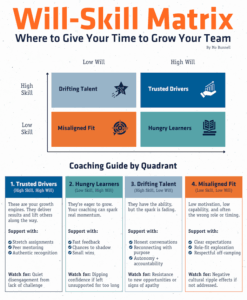It’s a typical situation every leader faces: the talented employee who misses deadlines, the high-potential team member who appears disengaged, or the new hire struggling to master a core skill.
Our initial response, shaped by decades of traditional management, is often to escalate—imposing tighter controls, issuing formal warnings, or implementing stricter policies. We see the situation as a “battle of wills,” assuming the employee chooses not to comply.
But what if that assumption is the most significant leadership failure?
Psychologist Stuart Ablon, in his insightful work highlighted on the Hidden Brain (https://www.hiddenbrain.org/podcast/reframing-the-battle-of-wills/) podcast (“Reframing the Battle of Wills”), offers a powerful correction: when people aren’t meeting expectations, it’s not because they won’t, but because they can’t—yet.
A lagging skill or unmet need prevents them from doing so.
For a leader, this shift in perspective is transformative. It moves us from a punitive enforcement role to an empowering coaching role. Authentic leadership is not about managing compliance; it’s about identifying the constraint and providing the necessary resources—the skill training or emotional support—to overcome it. Consequences only evoke fear; skills and support foster capability and commitment.
🎯 The Will-Skill Matrix: A Leader’s Diagnostic Tool
To effectively adopt this coaching mindset, we need an accurate method to identify why a team member is struggling. The Will-Skill Matrix (popularised by thinkers like Mo Bunnell—https://bunnellideagroup.com/) is crucial for leaders as a diagnostic tool. By mapping an individual’s Will (motivation, engagement) against their Skill (capability, experience), we can quickly determine the proper leadership intervention, ensuring we allocate our most valuable resource—our time—toward the highest-leverage activity.
🤝 Leadership Strategies for Each Quadrant
A leader’s effectiveness depends on their ability to tailor support. Treating a high-skill, low-will employee (Drifting Talent) the same as a low-skill, high-will employee (Hungry Learner) is a recipe for failure.
1. Trusted Drivers: The Strategy of Elevation
Your Trusted Drivers are your most valuable asset. The leadership challenge here is not managing performance but managing opportunity.
- Support by: Assigning stretch tasks that challenge their limits, appointing them as peer mentors to utilize their expertise, and providing genuine, visible recognition to strengthen their dedication.
- The Ablon Connection: Their basic needs are satisfied, and they have the necessary skills. The next unmet need is autonomy and mastery—hand them the ball and step back.
2 Hungry Learners: The Strategy of Scaffolding
These individuals are the most clear example of Ablon’s “lagging skill” diagnosis. They have the desire, but their ability needs improvement.
- Support by: Providing quick, tactical feedback; organizing shadowing opportunities with experts; and designing work for small, regular wins to build competence and sustain momentum.
- The Ablon Connection: Centre the coaching on skill development. Instead of punishing a mistake, ask: “What skill was needed in that moment that we can practice next time?”
. Drifting Talent: The Strategy of Re-Engagement
This is the quadrant where leaders most often mistakenly resort to punitive action, confusing apathy with defiance. The issue stems from an unmet need—a disconnection from the mission, the team, or their personal growth.
- Support with: Initiate honest, challenging conversations to diagnose the disconnect, facilitate reconnecting with purpose (tying their work back to the organizational vision), and allow for measured increases in autonomy and accountability to re-instill ownership.
- The Ablon Connection: The punitive approach fails because it worsens the individual’s feeling of being controlled and unheard. The solution is the opposite: genuine dialogue to understand the unmet need for significance or belonging.
4. Misaligned Fit: The Strategy of Clarity
This quadrant is often the most challenging, requiring leaders to make difficult yet essential decisions. Prolonging a poor fit harms the individual, the team culture, and the bottom line.
- Support with: defining clear, measurable expectations for a short-term improvement plan; conducting role-fit exploration to assess whether an internal pivot is possible; and, if not, managing a respectful, professional transition or off-ramping.
- The Ablon Connection: Sometimes the “can’t” is a lasting situational barrier. Leadership involves recognizing when the current environment cannot accommodate the individual’s needs or development path, and having the bravery to act with openness and respect.
🌟 Leadership as Development
To lead effectively in the modern workplace, we need to abandon the belief that our role is to motivate people (which suggests they are naturally unmotivated) and instead recognize that our job is to remove obstacles, such as skill gaps or unmet needs.
By integrating the diagnostic perspective of the Will-Skill Matrix with Stuart Ablon’s empathetic framework, we turn every performance challenge from a frustrating battle of wills into a targeted development opportunity. This approach fosters resilient, skilled teams and creates a leadership legacy based on growth rather than control.
Would you like to explore a specific case study for one of these quadrants or discuss how to train your managers to use this matrix?
Thanks for reading. Please reply at any time with questions or feedback for our Team. |
Ready to accelerate your growth and solve your biggest organizational challenges? Here are three ways we can work together:
1:1 Coaching & Strategy Book a private session to help you map out and achieve your most ambitious goals for 2026 and beyond. Book a Keynote or Event. More than just “another keynote,” this message inspires, engages, and accelerates your Team to measurable success. Organizational Consulting I work with leaders who want to make their organizations more effective and robust. I have never met a leadership team too stupid to succeed, but I have met many that were too dysfunctional. I help teams become better aligned, clarify their purpose, and solve the core issues of politics, confusion, high turnover, and wasted resources. |
